
Technology at School: Good or Bad Idea?
Technology keeps evolving, we’re using screens on a daily basis, either for work or entertainment and innovations are on the rise with the aim of making our lives easier. On paper, the devices we use are helpful tools to get the job done, but in practice, when should we start using them? In what context? Shall we introduce technology early on at school?
For the past few years, some schools managed to acquire new material, including interactive whiteboards, more recent computers, etc. Is it beneficial for everyone or not? Should we worry about having kids learning on big screens all day? Let’s dive right into it.
IT at School

Generally speaking, during primary school, computers are barely touched upon with shorts sessions to get familiar with them, while in secondary school, you have a whole class dedicated to learn how to use Microsoft Word, maybe Excel, etc. In others words, students are in a supervised setting for maximum 2 hours a week, with a small break in between. Rather healthy and practical, right?
However, what would happen if most of their classes were given on an interactive whiteboard?
Technology in the Classroom

Based on numerous articles and research on the subject, here are the pros for using more technology in the classroom, either with interactive whiteboards, tablets or e-books:
- Proper training for the future;
- Individualized learning, allowing kids to learn at their own rhythm;
- Significant improvement in creativity, communication, teamwork and analytical approach;
- Schools are upgrading their program with unlimited resources;
- Students are more invested in class;
- Teachers can handle better their students thanks to automated tasks
Now, let’s see the cons:
- More screen time;
- It’s very distracting, making it difficult for kids to assimilate information;
- Typing instead of taking notes on paper has a huge influence on how students perform;
- Less social interactions;
- Open door for more cheating during homework, tests or exams;
- Budget-wise, can most schools afford new devices and software?;
- Time consuming for teachers since they first have to learn how to use everything, encode data and adapt the content based on their students, be able to solve technical issues, etc.
- Lack of training for teachers;
- Not every family can provide the technological resources their children need, leading to inequalities
Bottom Line
Overall, in a supervised setting, giving access to technology to kids or young students is the perfect introduction to feel more comfortable and get familiar with it. It can definitely add more fun and turn learning into something more positive.
However, it’s perhaps too soon to fully implement technology into education: teachers and schools do need more time and money to put a solid system into place that would benefit everyone, while keeping it healthy at the same time. Plus, further research on the subject would be helpful to make it happen.
At the end of the day, it might be worth wondering if education should be updated in its entirety first before upgrading their facilities.





